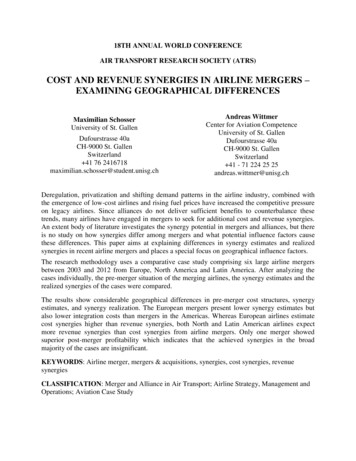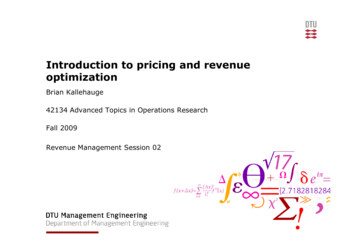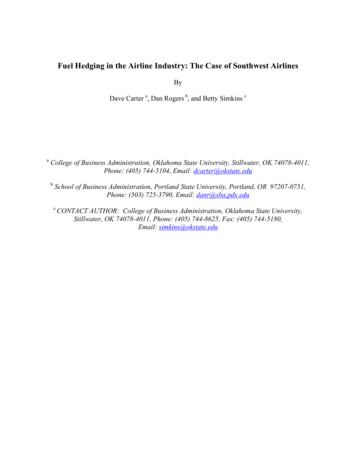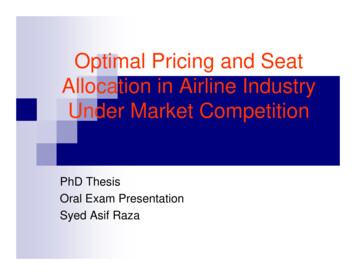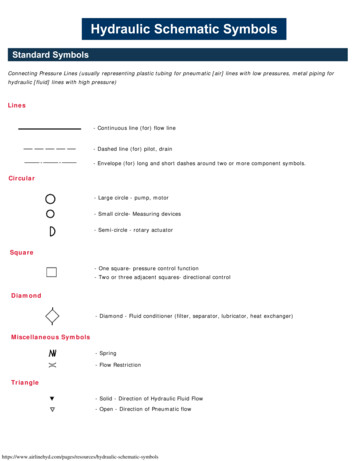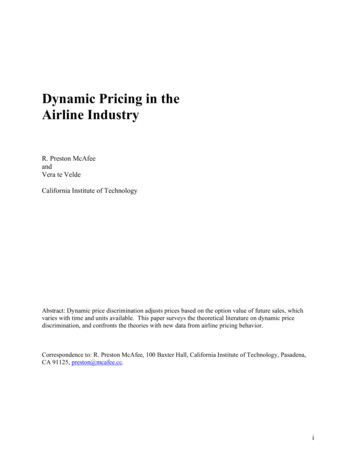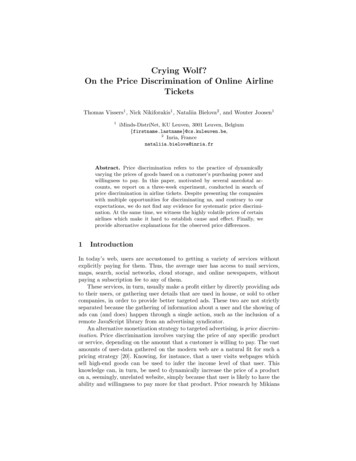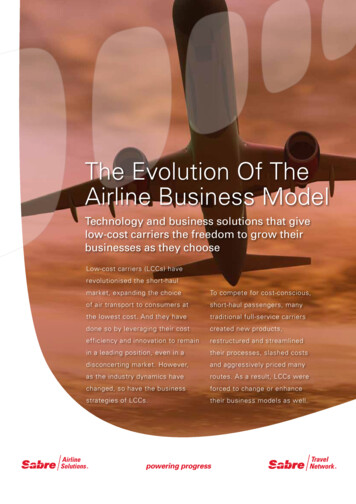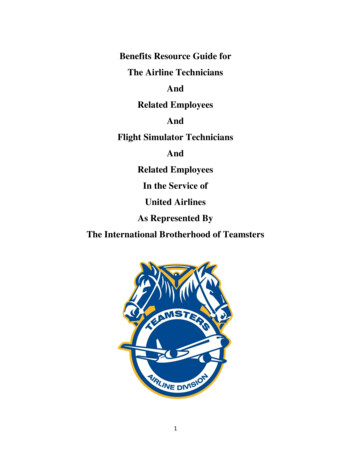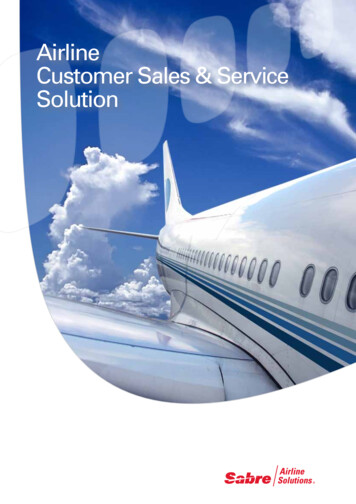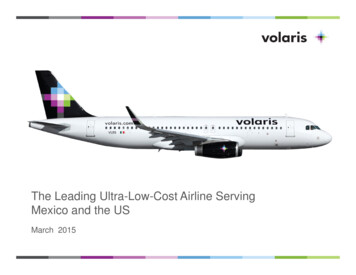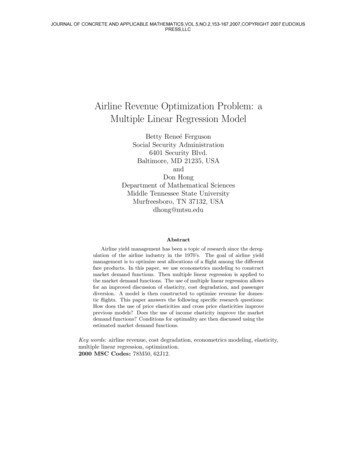
Transcription
JOURNAL OF CONCRETE AND APPLICABLE MATHEMATICS,VOL.5,NO.2,153-167,2007,COPYRIGHT 2007 EUDOXUS 153PRESS,LLCAirline Revenue Optimization Problem: aMultiple Linear Regression ModelBetty Reneé FergusonSocial Security Administration6401 Security Blvd.Baltimore, MD 21235, USAandDon HongDepartment of Mathematical SciencesMiddle Tennessee State UniversityMurfreesboro, TN 37132, USAdhong@mtsu.eduAbstractAirline yield management has been a topic of research since the deregulation of the airline industry in the 1970’s. The goal of airline yieldmanagement is to optimize seat allocations of a flight among the differentfare products. In this paper, we use econometrics modeling to constructmarket demand functions. Then multiple linear regression is applied tothe market demand functions. The use of multiple linear regression allowsfor an improved discussion of elasticity, cost degradation, and passengerdiversion. A model is then constructed to optimize revenue for domestic flights. This paper answers the following specific research questions:How does the use of price elasticities and cross price elasticities improveprevious models? Does the use of income elasticity improve the marketdemand functions? Conditions for optimality are then discussed using theestimated market demand functions.Key words: airline revenue, cost degradation, econometrics modeling, elasticity,multiple linear regression, optimization.2000 MSC Codes: 78M50, 62J12.
154HONG ET AL1IntroductionAirline yield management, a hot topic of research since the 1970’s, is used to optimize seat allocations of a single flight among the different fare products. Mostmodels for airline yield management can be grouped into one of the followingtwo categories: a price discrimination model or a product differentiation model.Price discrimination models assume that when a consumer chooses to purchasea lower priced fare product they do so at no additional cost. If the lower pricedfare product requires a purchase of 14 days in advance or any other restrictionsapplied to a discount purchase, which would not have been encountered by ahigher priced fare product, the assumption states that there is no cost to theconsumer for accepting more restrictions.There is an extensive study by Morrison and Winston [6] which estimatesthe additional costs for accepting more restrictions. Their study supports theneed to eliminate the assumption imposed by price discrimination models. Theother category, product differentiation models, assumes the demand for fareproduct i is independent of the demand for fare product j and independent ofthe price of any other fare products. This paper supports the need to eliminatethe assumptions imposed by both the price and product discrimination models.Botimer and Belobaba [2] introduced a generalized cost model of airlinefare product differentiation. Their model for air travel demand in an origindestination market is extended to include degradation costs and passenger diversion. These extensions eliminate the unrealistic assumptions made by previousprice discrimination models and product differentiation models. Degradationcosts are the costs to consumers who wish to downgrade to a lower fare product. The lower fare product requires the acceptance of a restriction(s) whichmay come as a cost to the consumer. Their initial demand function withoutdegradation costs isi 1XQi fi (Pi ) Qj ,j 1where Qi denotes the number of passengers purchasing fare product i, fi ( · ) isthe market demand function for fare product i, Pi is the price of fare product i,and Qj is the number of passengers held captive to fare products less restrictedthan fare product i.Note that fare product i 1 is defined to impose more restrictions than fareproduct i. The model in [2] is designed with the following criteria:(1) fi 1 fi fj for j i.(2) The market demand function is a positive function determined by customers,competitors, prices, etc. and exploited by the individual airlines.(3) The consumers arrive in increasing order of willingness to pay.(4) Demand for fare product i is derived from unrestricted fare product 1.To include degradation costs, costs associated with consumers for accepting
LINEAR REGRESSION MODEL155more restrictions, their demand function then becomesQi 1 fi 1 (Pi 1 i 1Xi 1Xcj ) j 1Qj ,j 1where, ci is the cost to each consumer for accepting the imposed restrictions.Note that c1 is zero because there are no restrictions for the full fare product,and thus no cost to consumers. Their model assumes ci is a constant costfunctional form for simplicity reasons. The consumers perceived cost of fareproduct i is higher than the actual price of fare product i. Thus as Botimer andBelobaba state in [2], “their willingness to purchase fare product i is reducedby ci as compared to fare product i 1. ”The model in [2] for air travel demand is extended to include passengerdiversion to eliminate the assumption of previous product differentiation models.This is designed to include a fixed percentage of the expected demand for anyfare product. Thus the number of passengers actually purchasing fare producti is represented by qi ,NXqi (1 dij )Qi j i 1i 1Xdji Qj ,j 1where, dij denotes the percentage of passengers diverting from fare product i toa more restricted fare product j.Finally, their optimizing revenue function is constructed only for the linearcase of the constant cost model where,Pi 1Pi 1Pi P0 a j 1 Qj j 1 cjis strictly nonincreasing. The Lagrange Multiplier Method is used to maximizethe following revenue objective function which includes degradation costs andpassenger diversion:R NXi 1 (1 NXdij )Qij [P0 ai 1N XNXi 1 j i 1dji Qj [P0 aiXQk k 1Qk cr ]r 1k 1jXiXjXcr ].r 1This model leaves room for improvement as most models do. In [2], theauthors mentioned several areas for further research. Under the topic on passenger diversion, the authors suggested the use of cross price elasticity effects ina model. Under the topic on degradation costs, the authors suggested that constant cost formulation does not realistically reflect consumer behavior. That is,“costs incurred may differ by passenger rather than being constant.” So there is
156HONG ET ALa need to determine the effects of passenger behavior. In this paper, comparingto the model in [2] constructed only for the linear case of the constant costmodel, we construct a model of market demand function using econometricsmodeling that could be used for forecasting consumer behavior in the airlineindustry. Based on a stratified random sample from the U.S. Department ofTransportation’s Domestic Airline Fares Consumer Report of 1997, we determine the market demand functions including price and cross price elasticity withand without income elasticity using multiple linear regression. We further analyze these results and determine a generalized objective function. In the finalsection, we apply Lagrange multiplier method to solve the the airline revenuemaximization problems.2Market Demand FunctionEconometrics modeling of the air travel demand will allow us to observe costdegradation and passenger diversion in action. Instead of fixing the percentageof diversions between the fare products and having a constant degradation costci , we shall model existing behaviors in hopes to be able to better forecast futureconsumer behavior. For research of econometric modeling, we refer to the book[7]: Econometric Models and Econometric Forecasts.To understand econometrics modeling and how this can work for airtraveldemand, we first recall some basic concepts of elasticity. An elasticity measuresthe effect on the dependent variable of a 1 percent change in an independentvariable. Therefore, we can monitor change of the dependent variable Qi of a 1percent change in an independent variable Pi , where Qi is demand for a productand Pi is the price for this product. This situation is called price elasticity. Wecan also monitor Qi of a 1 percent change in another independent variable Pj .This situation is called cross price elasticity. Elasticities are easy to work withdue to the facts that their values are unbounded, values may be positive ornegative, and are unit-free. A market demand function which includes priceelasticity and cross price elasticity may prove to be a more realistic approachto consumer behavior.Econometric modeling for demand yields the following equation for fareproduct iβQi βi0 Piβi Πi6 j Pj ij e i ,where, Qi is a continuous, dependent variable representing quantity demandedfor fare product i, βi0 is an unbounded and unit-free constant, βi is the priceelasticity which is unbounded and unit-free for fare product i, βij is the unbounded and unit-free cross price elasticity for fare product i by change in pricej, Pi is an independent variable representing price of fare product i, and i isthe error term which assumes a normal distribution.An econometric model of airline demand shall yield as many equations asthere are fare products. Thus for simplicity purposes we shall model demand
LINEAR REGRESSION MODEL157aggregating passenger services into three fare products. That is, fare product1 will have demand function Q1 representing demand for first class or full fareproducts, fare product 2 will have demand function Q2 representing demand forstandard economy class or first class with some restrictions, and fare product3 will have demand function Q3 representing the demand for discount fareclassor standard economy class with many more restrictions. Q2 usually requiresadvance purchase of 3 days while Q3 usually requires an advance purchase of 14or more days.It is clear that we only want to include necessary independent variables. Itis not necessary to include P3 in Q1 due to the fact that demand in first classis not effected by price changes of fares in the discount fareclass. However,as we will see, we must include P1 , P2 , and P3 in Q2 and only P3 and P2 inQ3 . Realistically, demand should be effected by the above fareclass and belowfareclass changes in price. Thus standard economy fareclass, in the three fareproduct model, is the only fare product that has two cross price elasticities. Inorder to linearize the model, we take the natural log of each Qi yielding thefollowing three fare product market demand functions:ln Q1 β10 β1 ln P1 β12 ln P2 1 ,ln Q2ln Q3 β20 β2 ln P2 β21 ln P1 β23 ln P3 2 , β30 β3 ln P3 β32 ln P2 3 .For the multiple linear regression model, we let qi ln Qi and xi ln Pi . Thuswe have the following three market demand functions:q1 β10 β1 x1 β12 x2 1 ,q2q3 β20 β2 x2 β21 x1 β23 x3 2 ,β30 β3 x3 β32 x2 3 .The assumptions of these multiple linear regressions in [7] are: the relationship between qi and xi is linear, the xi ’s are non-stochastic variables and inaddition, no exact linear relationship exists between two or more independentvariables, the error term has zero expected value for all observations, the errorterm as constant variance for all observations, and the error term is normallydistributed.With these assumptions, we would like to use the model to analyze consumer behavior through the use of price elasticities and cross price elasticities.Therefore, we select a sample of approximately 250 flights to monitor consumerbehavior. The data from the 250 flights are the data for qi ’s and xi ’s in the abovemodel. We use multiple linear regression to search for parameter estimates, β’s,that minimize the error sums of squares.P (j)P (j)(j)The squared sum of errors is SSEi j (ei )2 j (qi qbi )2 , where(j)qi(j)is the observed value for the natural log of demand of the flight j and qbi
158HONG ET ALis the predicted value for the natural log of the demand of the flight j. Thuswe will have 250 equations for quantity demanded for each of the qi ’s withthe unknown elasticities β’s. Using multiple linear regression we will have onepredicted demand function for each of the qi ’s:qbi βbi0 βbi xi βbi(i 1) xi 1 βbi(i 1) xi 1 , i 1, 2, 3.This model needs more than three observations, that is, three or more flights.Multiple linear regression is used to solve for βbi and βbij for i 6 j. Then βbi0can be solved. The parameter estimates are defined as the following for qb1 andsimilarly for qb2 and qb3 :P250 (i) (i) P250 (i)P250 (i) (i) P250 (i) (i)( i 1 x1 q1 )( i 1 (x2 )2 ) ( i 1 x2 q1 )( i 1 x1 x2 )bβ1 ,P250 (i)P250 (i)P250 (i) (i)( i 1 (x1 )2 )( i 1 (x2 )2 ) ( i 1 x1 x2 )2P250 (i) (i) P250 (i)P250 (i) (i) P250 (i) (i)( i 1 x2 q1 )( i 1 (x2 )2 ) ( i 1 x1 q1 )( i 1 x1 x2 )bβ12 ,PP250 (i) (i) 2(i) 2 P250(i) 2( 250i 1 (x1 ) )(i 1 (x2 ) ) (i 1 x1 x2 )andP250(i)βb10 q̄1 βb1 x̄1 βb12 x̄2 ,(i)1where q̄1 250i 1 q1 , and q1 is the observed value for the natural log ofdemand of the flight i. x̄1 and x̄2 are defined similarly.3Main Results and AnalysisTo estimate our price and cross price elasticities, a stratified random sample ischosen from U.S. Department of Transportation’s Domestic Airline Fares Consumer Report of 1997. This report of the 1,000 largest city-pair markets withinthe 48 states accounts for approximately 75 percent of all 48-state passengersflights. The 1,000 flights are divided into groups determined by their nonstopdistance. A separate simple random sample (SRS) is used to select from thelist of flights whose nonstop distance ranges from 100–300 miles, 500–700 miles,900–1100 miles, 1300–1500 miles, and 1900–2100 miles. The combined SRS ineach category yields 250 randomly selected flights; 25 percent of the populationof interest.The prices used for the three fare class model are current prices given fromvarious search engines comprised of www.flyaow.com, www.travelocity.com, andwww.bestlodgings.com. These search engines allow us to determine the averageprices for each of the three fare classes. The price for standard economy is determined by requiring an advanced purchase of 3 days and 14 days for discountfareclass. The model
Airline Revenue Optimization Problem: a Multiple Linear Regression Model Betty Rene e Ferguson Social Security Administration 6401 Security Blvd. Baltimore, MD 21235, USA and Don Hong Department of Mathematical Sciences Middle Tennessee State University Murfreesboro, TN 37132, USA dhong@mtsu.edu Abstract Airline yield management has been a topic of research since the dereg
